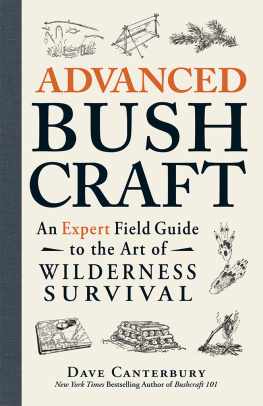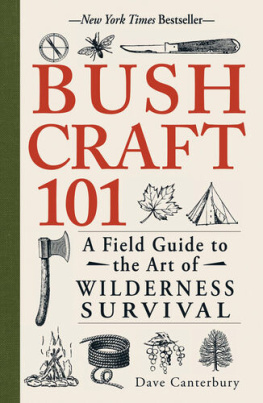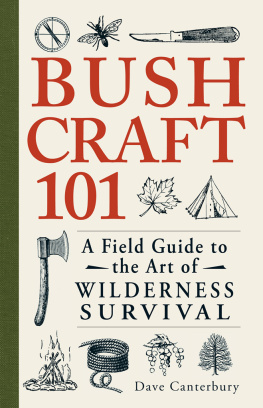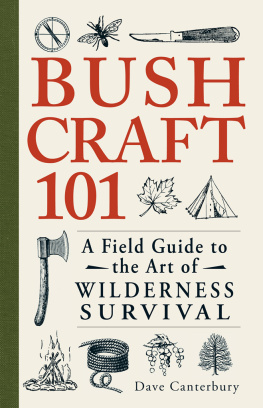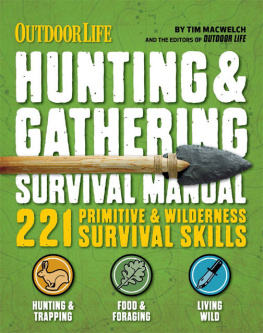Contents
Guide
The Bushcraft Field Guide to Trapping, Gathering, and Cooking in the Wild
Dave Canterbury, New York Times Bestselling Author of Bushcraft 101

Avon, Massachusetts
Copyright 2016 by F+W Media, Inc.
All rights reserved.
This book, or parts thereof, may not be reproduced in any form without permission from the publisher; exceptions are made for brief excerpts used in published reviews.
Published by
Adams Media, a division of F+W Media, Inc.
57 Littlefield Street, Avon, MA 02322. U.S.A.
www.adamsmedia.com
ISBN 10: 1-4405-9852-5
ISBN 13: 978-1-4405-9852-4
eISBN 10: 1-4405-9853-3
eISBN 13: 978-1-4405-9853-1
Readers are urged to take all appropriate precautions before undertaking any how-to task. Always read and follow instructions and safety warnings for all tools and materials, and call in a professional if the task stretches your abilities too far. Although every effort has been made to provide the best possible information in this book, neither the publisher nor the author are responsible for accidents, injuries, or damage incurred as a result of tasks undertaken by readers. This book is not a substitute for professional services.
This publication is designed to provide accurate and authoritative information with regard to the subject matter covered. It is sold with the understanding that the publisher is not engaged in rendering legal, accounting, or other professional advice. If legal advice or other expert assistance is required, the services of a competent professional person should be sought.
From a Declaration of Principles jointly adopted by a Committee of the American Bar Association and a Committee of Publishers and Associations
Many of the designations used by manufacturers and sellers to distinguish their products are claimed as trademarks. Where those designations appear in this book and F+W Media, Inc. was aware of a trademark claim, the designations have been printed with initial capital letters.
Cover design by Stephanie Hannus.
Cover images Clipart.com.
Interior illustrations by Eric Andrews.
Insert photos iStockphoto.com and 123RF.
This book is available at quantity discounts for bulk purchases. For information, please call 1-800-289-0963.
I would like to dedicate this book to my loving granddaughter Layla. In the many books, articles, and other forms of media I generate, I wish that she will be able to see me and read my words many years from now and that her children may know who their grandfather was, and that he enjoyed passing on the knowledge of his forefathers so that she may pass on this knowledge to future generations through my written words. I think that leaving a legacy for others to enjoy is a true blessing and gift from God, and this gift I dedicate to her.
Acknowledgments
When you begin to research for a book or you begin to study a subject in depth you inevitably look for sources of information you can trust to learn from, then you go out and you practice what you have read or seen, and you quickly get a feel for what actually works for you. In cooking, everyone has a different taste for what they like and you adapt to make the foods taste good to you.
So when I began to look through source materials I found myself going right back to some of the great authors I had learned from in the past as they had already adapted many methods of cooking to the wilderness. The great thing about the outdoors is eating in it! Nothing tastes quite as good as it does when cooked over an open fire.
To that end authors like Horace Kephart, George Washington Sears, Hyatt Verrill, Steven Watts, David Wescott, Ellsworth Jaeger, Bernard Mason, Warren Miller, and many others already have valuable information on what apparatus to use for cooking this or that, and how to adapt that kitchen recipe to the field. All one has to do is practice it and adapt it to his personal gear selection and taste for foods. So to that end I have compiled this book on camp cooking according to my style of woodland cooking. I thank all of the above authors and many others for their tireless efforts to educate us all in the skills that have somewhat become lost in modern times. And with this book I hope to rekindle that love of cooking in the great outdoors.
I would last but not least say that truly God is the provider and we benefit from the vast amount of resources he has provided. It is our responsibility to understand how to utilize them so that we can become more self-reliant.
Introduction
This book will be useful to anyone who recreates outdoors whether it be for a day hike, a trail hike, a weekend camp, or a longer-term hunting trek. It is written with the ultimate goal of understanding the difference between wants and needs when it comes to foods and their preparations.
When we think about bushcraft, especially when we introduce survival mentality into the equation, we often think of living completely off the land and meeting all of our food intake needs from the resources around us within the landscape. However, the fact is we will spend much more time in nature on a recreational basis than in a true survival situation.
At the same time we cannot go on a weeklong hunting camp and expect to live completely from what we can provide by rod and gun or even necessarily from traps and foraging. Seasonality plays a large role in foraging. Weather can affect game movements, and we are at the mercy of the season for legal take. Size limits restrict fishing... the list goes on. So we cannot expect in the modern day to just wander off with a few friends and live completely off the land even for a week in most areas and in most seasons.
To that end many books have been written over the years that speak to what implements and foods we can take with us and how best to store and use it, what implements we will need for food preparation, and what different food offerings can be made from just a few simple sundries.
Sometimes we can take more extravagant amounts of cooking kit and foodstuffs with us depending on our form of conveyance, and other times we are limited to what we can personally carry. Understanding this and adapting can make life on the trail very comfortable and allow us to smooth it as the sportswriter and conservationist Nessmuk would say.
This book is an attempt to capture the gear, methods, and types of sundries we have available to us now to get food from our surroundings. While Ill include traditional foods and methods of gathering, catching, and preparing food, Ill also give attention to what we have available now that may not have been attainable for those writing in the past.
It is no secret that there is romance in living as close to nature as possible. Roasting a nice piece of fresh game meat over the fire on a forked stick, while a small ash cake is cooking within the coals, and a nice cup of hot coffee poured from the kettle sets the tone for an evening of true woodsmanship under the stars. We should take advantage of this at every opportunity, but we should also be prepared to use what we can pack to supplement that food if things dont work out as we had hoped.
While we can fashion cooking implements from natural materials to help us cut weight from packing them in, we should also realize many items available in the modern day make cooking very convenient. New materials like titanium weigh less for an entire cook kit than a single pan carried in the 1920s and 1930s. We must understand what types of materials suit our needs best and know the pros and cons of these materials, as well as what implements we can fashion from the woods to aid us in cooking, especially if we are packing in by foot and cannot afford the weight of heavy fire irons and such.


